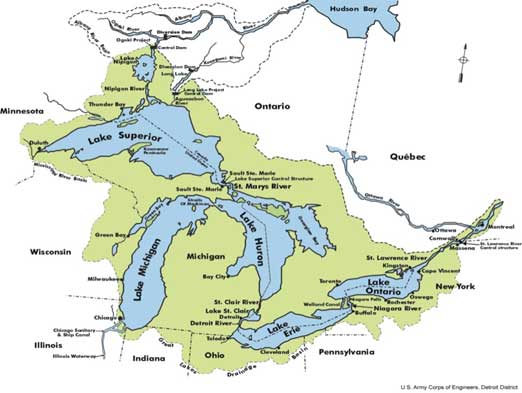Please review this renewed commitment to protect the Great Lakes Quality and Ecosystem Health
https://ec.gc.ca/lcpe-cepa/default.asp?lang=En&n=E9A42FF1-1&printfullpage=true#ws93D66DC4
EXCERPTS
Canada-Ontario Agreement on Great Lakes Water Quality and Ecosystem Health, 2014
Introduction
Download Agreement in PDF version (1MB)
THIS AGREEMENT IS EFFECTIVE THE 18TH DAY OF DECEMBER, 2014
BETWEEN
HER MAJESTY THE QUEEN IN RIGHT OF CANADA (CANADA)
Represented by
The Honourable Leona Aglukkaq, Minister of the Environment (and Minister Responsible for Parks Canada Agency)
The Honourable Gerry Ritz, Minister of Agriculture and Agri-Food
The Honourable Gail Shea, Minister of Fisheries and Oceans
The Honourable Rona Ambrose, Minister of Health
The Honourable Greg Rickford, Minister of Natural Resources
The Honourable Lisa Raitt, Minister of Transport
The Honourable Denis Lebel, President of the Queen’s Privy Council for Canada, Minister of Infrastructure, Communities and Intergovernmental Affairs
AND
HER MAJESTY THE QUEEN IN RIGHT OF ONTARIO (ONTARIO)
Represented by
The Honourable Glen R. Murray, Minister of the Environment and Climate Change
The Honourable Bill Mauro, Minister of Natural Resources and Forestry
The Honourable Jeff Leal, Minister of Agriculture, Food and Rural Affairs
WHEREAS Canada and Ontario (the Parties) affirm that this Agreement is guided by the shared vision of a healthy, prosperous and sustainable Great Lakes for present and future generations;
AND WHEREAS the Parties recognize that the Great Lakes region is home to approximately 33 percent of Canada’s population, and contains seven of Canada’s twenty largest cities, and the Great Lakes directly provide drinking water to over 10 million residents of Ontario;
AND WHEREAS the Parties acknowledge that the Great Lakes region plays a vital role in the physical, social and economic life of Canada, Ontario’s Great Lakes basin contains 40 percent of the country’s economic activity, including approximately 25 percent of Canada’s agricultural production, and more than 75 percent of Canada’s manufacturing activity;
AND WHEREAS environmentally sustainable and responsible economic activity, resource development, and innovation is important to the long-term prosperity of the Great Lakes region;
AND WHEREAS the Parties acknowledge that the Great Lakes contain approximately 20 percent of the surface freshwater in the world, and that less than 1 percent of the water is renewed annually by precipitation;
AND WHEREAS the Parties have shared jurisdiction over the Great Lakes, which makes coordination and cooperation essential to their restoration, protection and conservation, and acknowledge that Ontario has the longest coastline of any jurisdiction on the Great Lakes;
AND WHEREAS the Parties acknowledge that the Great Lakes are ecologically important, supporting outstanding biological diversity and significant fisheries;
AND WHEREAS the Parties acknowledge the close connection between Great Lakes water quality and human health and the positive effects on individuals and communities from the use and enjoyment of healthy Great Lakes;
AND WHEREAS since 1971 the Parties have worked together through a series of Canada-Ontario Agreements that have guided their efforts to improve water quality and ecosystem health of the lakes, and contributed to meeting Canada’s obligations under the Canada-United States Great Lakes Water Quality Agreement;
AND WHEREAS the efforts of the Great Lakes community contribute to the restoration, protection and conservation of the Great Lakes;
AND WHEREAS the Parties acknowledge that First Nations and Métis within the Great Lakes basin value their spiritual and cultural relationship with the Great Lakes, and that their traditional knowledge may assist efforts to restore, protect and conserve the Great Lakes;
AND WHEREAS the Parties recognize that progress has been made in the Great Lakes in reducing the release of harmful pollutants, improving and protecting fish and wildlife habitat, restoring a number of Areas of Concern, and fostering a sense of stewardship;
AND WHEREAS the Parties recognize that, despite the progress made, the Great Lakes are currently exhibiting symptoms of stress due to human activities undertaken within the basin and elsewhere in the world;
AND WHEREAS the Parties recognize the need to strengthen efforts to address new and continuing threats to Great Lakes water quality and ecosystem health, including aquatic invasive species, excessive nutrients, harmful pollutants, discharges from vessels, climate change, and the loss of habitats and species;
AND WHEREAS the Parties recognize that in addition to offshore waters, nearshore areas must be restored, protected and conserved because they are the major source of drinking water for communities, are where most human commerce and recreation occur, and are the critical ecological link between watersheds and the open waters of the Great Lakes;
AND WHEREAS the Parties acknowledge that the vast majority of public stormwater and wastewater treatment infrastructure in Canada is owned, operated and maintained by provincial, territorial or municipal governments and that those governments are therefore also responsible for identifying priority actions and projects within their jurisdictions;
AND WHEREAS the Parties acknowledge that the federal Wastewater Systems Effluent Regulations, 2012, establish national effluent quality standards for secondary wastewater treatment in Canada;
AND WHEREAS the Parties recognize that restoration and enhancement of Great Lakes water quality and ecosystem health cannot be achieved by addressing individual threats in isolation, but rather depend upon the application of an ecosystem approach that addresses individually and cumulatively all sources of stress to the Great Lakes;
AND WHEREAS the Parties acknowledge that Canada is responsible for meeting its binational commitments in the Canada-United States Great Lakes Water Quality Agreement, and Ontario agrees to support Canada in the manner set out in this Agreement;
AND WHEREAS the Parties acknowledge that the quality of the waters of the Great Lakes may affect the quality of the waters of the St. Lawrence River downstream of the international boundary;
AND WHEREAS the Parties affirm their commitment to work together to implement the Canada-United States Great Lakes Water Quality Agreement and advance the environmental goals of Ontario’s Great Lakes Strategy in a manner consistent with the vision and purpose of this Agreement;
AND WHEREAS the Parties are committed to continuing to work together, and to engaging the Great Lakes community on a good governance basis, to restore, protect and conserve the Great Lakes for present and future generations.
NOW THEREFORE the Parties have agreed as follows:
ARTICLES
ARTICLE I
Definitions
In this Agreement:
- (a) “Agreement” means the Canada-Ontario Agreement on Great Lakes Water Quality and Ecosystem Health, 2014, including any Annexes;
- (b) “Canada-United States Great Lakes Water Quality Agreement” means the Great Lakes Water Quality Protocol of 2012 between Canada and the United States;
- (c) “Chemicals of Concern” means chemicals which Canada and Ontario agree are of concern to human health or the environment in the Great Lakes and should be considered a priority for specific action(s). A Chemical of Concern could be considered for nomination under the Chemicals of Mutual Concern Annex of the Canada-United States Great Lakes Water Quality Agreement;
- (d) “Good Governance” means pursue a decision-making process based on public participation, transparency and accountability;
- (e) “Great Lakes” means the waters of Lakes Superior, Huron, Michigan, Erie and Ontario and the connecting river systems of St. Marys, St. Clair including Lake St. Clair, Detroit, Niagara and St. Lawrence at the international boundary or upstream from the point at which this river becomes the international boundary between Canada and the United States, including all open and nearshore waters;
- (f) “Great Lakes Basin Ecosystem” means the interacting components of air, land, water and living organisms, including humans, and all of the streams, rivers, lakes, and other bodies of water, including groundwater, that are in the drainage basin of the Great Lakes and the St. Lawrence River at the international boundary or upstream from the point at which this river becomes the international boundary between Canada and the United States;
- (g) “Great Lakes community” means First Nations and Métis; municipal governments; conservation authorities; non-government organizations; the scientific community; the industrial, agricultural, recreational, tourism and other sectors; and members of the public with an interest in Great Lakes issues;
- (h) “Harmful Pollutants” are chemicals or pathogens that have an adverse effect on human or ecological health including, but not restricted to, chemicals of concern or substances of emerging concern;
- (i) “Ontario’s Great Lakes Strategy” means the 2012 document that maps out the Province of Ontario’s priorities and plans for action to restore, protect and conserve the Great Lakes.
ARTICLE II
Purpose
- The purpose of this Agreement is to restore, protect and conserve Great Lakes water quality and ecosystem health in order to assist in achieving the vision of a healthy, prosperous and sustainable region for present and future generations.
- The Parties commit to continuing to work together in a cooperative, coordinated and integrated fashion, with each other and with others around the Great Lakes on a good governance basis, to achieve the vision.
- To achieve the vision, the Agreement:
- (a) establishes principles that will guide the actions of the Parties;
- (b) describes the development of Annexes to respond to existing or emerging environmental issues;
- (c) sets in place administrative arrangements for the effective and efficient management of the Agreement;
- (d) establishes common priorities, goals, results and commitments for the restoration, protection and conservation of the Great Lakes; and
- (e) establishes a commitment to report on the progress being made in achieving the goals and results of the Agreement, to be aligned with the three-year binational reporting requirements established under the Canada-United States Great Lakes Water Quality Agreement.
- By defining a vision for the Great Lakes, specific goals and results, and the commitment to action by the Parties, this Agreement is intended to give momentum to wider efforts and to facilitate collaborative arrangements and collective action among all people and organizations with an interest in the Great Lakes.
- Implementation of this Agreement will contribute to meeting Canada’s obligations under the Canada-United States Great Lakes Water Quality Agreement and Ontario’s Great Lakes Strategy.
ARTICLE III
Principles
The following principles will guide the actions of the Parties under the Agreement:
- (a) Accountability – remain accountable to citizens by establishing clear goals, results and commitments for this Agreement and reporting regularly on progress in relation to environmental conditions;
- (b) Adaptive Management – conduct activities with openness, innovation and a view to continuous improvement to ensure effective and efficient management of the Agreement;
- (c) Collaboration, Cooperation and Engagement – ensure that the decision-making process provides the Great Lakes community with meaningful opportunities to discuss, advise and participate directly in activities that support the Agreement, and incorporates consideration of opinions and advice from the Great Lakes community;
- (d) Communication – ensure that effective methods are used to inform the public of the importance of the Great Lakes, the increasingly complex environmental challenges faced by the Great Lakes and ongoing efforts to overcome the challenges, and to encourage collaborative and individual action and stewardship to restore, protect and conserve the Great Lakes;
- (e) Conservation – promote the conservation and wise use of energy, water and other resources to sustain the physical, chemical and biological integrity of the Great Lakes;
- (f) Cumulative Effects – consider the combined impacts of individual actions on the environment;
- (g) First Nations and Métis – their identity, cultures, interests, knowledge and traditional practices will be considered by the Parties in the restoration, protection and conservation of the Great Lakes Basin Ecosystem;
- (h) Free Exchange of Information – collect data once, closest to the source, in the most efficient manner possible and share the information with others;
- (i) Net Gain – design human development and management actions to maximize environmental benefits rather than acting only to minimize environmental costs;
- (j) Polluter Pays – recognize that the polluter should bear the cost of pollution;
- (k) Pollution Prevention – use processes, practices, materials, products, substances or energy that avoid or minimize the creation of pollutants and waste and reduce the overall risk to the environment or human health;
- (l) Precautionary Principle – where there are threats of serious or irreversible environmental damage, lack of full scientific certainty shall not be used as a reason for postponing cost-effective measures to prevent environmental degradation;
- (m) Science-Based Management – provide advice to establish management priorities, policies and programs based on best available science, research and knowledge, including traditional knowledge when available;
- (n) Sustainability – consider social, economic and environmental demands to balance the needs of the present without compromising the ability of future generations to meet their own needs;
- (o) Virtual Elimination – adopt the principle of virtual elimination of Chemicals of Concern, as appropriate; and
- (p) Zero Discharge – apply the philosophy of zero discharge of releases of Chemicals of Concern, as appropriate.





